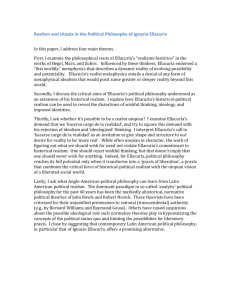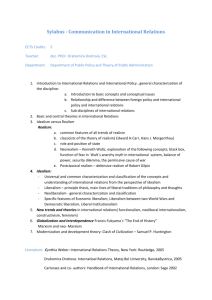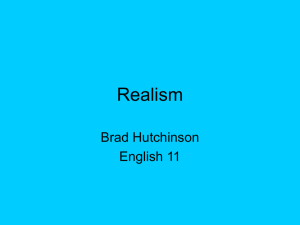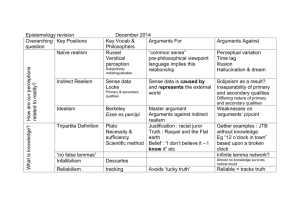peircean realism, critical realism, and some epistemic problems of
advertisement
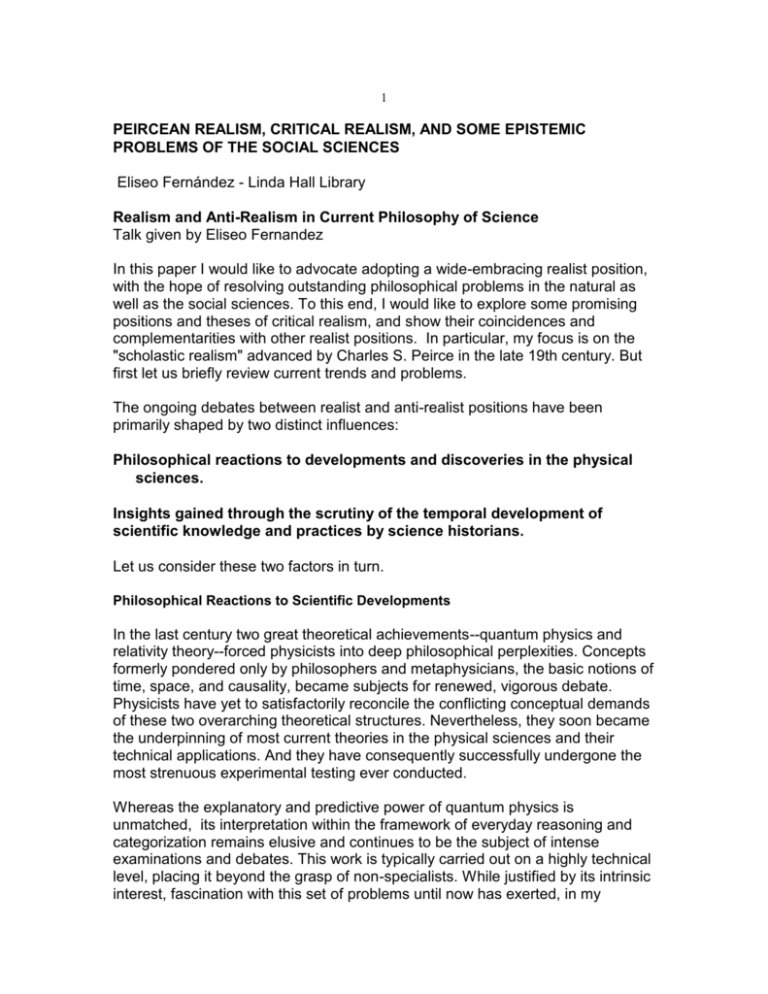
1 PEIRCEAN REALISM, CRITICAL REALISM, AND SOME EPISTEMIC PROBLEMS OF THE SOCIAL SCIENCES Eliseo Fernández - Linda Hall Library Realism and Anti-Realism in Current Philosophy of Science Talk given by Eliseo Fernandez In this paper I would like to advocate adopting a wide-embracing realist position, with the hope of resolving outstanding philosophical problems in the natural as well as the social sciences. To this end, I would like to explore some promising positions and theses of critical realism, and show their coincidences and complementarities with other realist positions. In particular, my focus is on the "scholastic realism" advanced by Charles S. Peirce in the late 19th century. But first let us briefly review current trends and problems. The ongoing debates between realist and anti-realist positions have been primarily shaped by two distinct influences: Philosophical reactions to developments and discoveries in the physical sciences. Insights gained through the scrutiny of the temporal development of scientific knowledge and practices by science historians. Let us consider these two factors in turn. Philosophical Reactions to Scientific Developments In the last century two great theoretical achievements--quantum physics and relativity theory--forced physicists into deep philosophical perplexities. Concepts formerly pondered only by philosophers and metaphysicians, the basic notions of time, space, and causality, became subjects for renewed, vigorous debate. Physicists have yet to satisfactorily reconcile the conflicting conceptual demands of these two overarching theoretical structures. Nevertheless, they soon became the underpinning of most current theories in the physical sciences and their technical applications. And they have consequently successfully undergone the most strenuous experimental testing ever conducted. Whereas the explanatory and predictive power of quantum physics is unmatched, its interpretation within the framework of everyday reasoning and categorization remains elusive and continues to be the subject of intense examinations and debates. This work is typically carried out on a highly technical level, placing it beyond the grasp of non-specialists. While justified by its intrinsic interest, fascination with this set of problems until now has exerted, in my 2 opinion, an exaggerated influence on current philosophy of science. The repercussions have been felt in both its epistemic and ontological dimensions. The extreme concentration devoted to these issues has eclipsed other equally valid philosophical problems within other physical disciplines, such as condensed matter physics, not to mention the philosophical problems of chemistry, biology, economics, and of the human sciences. Fueled by a new generation of philosophers in recent years, however, we have begun to see a renewed interest in these latter disciplines. The intense focus placed on fundamental physics has caused one especially profound effect: the narrowing of the very notion of realism. Since the time when logical empiricism dominated the philosophy of science, discussions about realism have generally addressed two topics: 1) questioning the existence or non-existence of the referents of theoretical terms (such as "electron" or "virtual particle"), and 2) the truth or perhaps the mere instrumental value of the theories in which they figure. Scientists and philosophers have developed empiricist and instrumentalist alternatives as a way to overcome what they see as serious obstacles in the path of a realist interpretation of theories.1 The Scrutiny of Historians The influence of historical research reacts with the first factor (philosophical reactions to scientific developments) in many ways. Through the work of science historians, we now recognize that both the development of our scientific knowledge and the process of its philosophical elucidation are shaped by contingent social and historical factors. They are not solely influenced by internal constraints, such as conceptual and logical necessities. The received philosophical tradition in the physical sciences has been characterized by a lack of consideration of social and other extratheoretical factors. We have witnessed in recent years a strong counter-reaction: a growing number of positions that seek a complete reversal from the traditional approach. They pursue a reductive account of scientific research and its products in terms of the social determinants of scientific work and its communication. As you know, in its extreme versions this reductionistic approach leads to the rejection of some of the most cherished scientific ideals, normally associated with the notions of truth and objectivity. It also tends to blur the distinction between science and ideology. Partisans of this approach are inclined to reject scientific realism, which they identify with absolute, transhistorical objectivism 2 and other alleged shortcomings in the traditions held by the Within the current framework, realists support their stance on the so-called "nomiracles" argument, according to which the empirical success and predictive 3 power of scientific theories would have the improbability of a miracle if they were devoid of reference. Their opponents, in turn, undermine the realist position by taking stock in some results provided by science historians. They point out that in the past there were many empirically successful theories that postulated theoretical entities that later had to be abandoned and replaced by new ones. Theories postulating the phlogiston, the caloric, or the various mechanical and chemical ethers proposed in the 19th century, are all illustrative examples 3. Realism and the Social Sciences The question of realism or anti-realism involves a wider range of considerations from the social sciences standpoint. In addition to the aforementioned issues, the social sciences perspective considers broad, urgent problems that address the very nature of scientific work and of its place within the entire scope of human endeavors, traditions, institutions, and aspirations. At stake is nothing less than the possibility that we humans might reach a rational understanding of ourselves as social beings and might be able to guide the transformation of our society through such understanding. While realists tend to be optimists in the face of such prospects, anti-realists are more likely to succumb to pessimism. The current, unprecedented expansion of unrestrained laissez faire capitalism is wedded to two pervasive views: an uncritical reliance on the benevolent powers of the market and the abhorrence of rational collective planning. These convictions have generated strong ideological pressures in favor of antirealist stances and pessimistic views about the powers of rationally guided inquiry and action. They permeate all domains of our culture, including the philosophy of science. New Trends in Realism As a reaction to this situation, partly on ideological grounds and partly by the influence of new philosophical insights, a new drive has begun in widely separate quarters to secure a sound, comprehensive realist vision of scientific work and its fruits. If successful, these efforts would not only clarify or solve epistemic problems of individual disciplines, but would also bridge the conceptual and methodological gap that has alienated the social from the physical sciences since the dawn of the Enlightenment. In natural philosophy this trend can be discerned, for example, in the Structural Realism of John Worrall, the Relational Realism of Carlo Rovelli, and the socalled Ithaca Interpretation of quantum physics4. In the social sciences the works of such sociologists as Pierre Bourdieu or Thomas Giddens (to name two of the best known) exhibit similar tendencies5. These new approaches share distinguishable features. One common trend is the recognition that relational structures are basic, irreducible components of 4 reality, in contrast to the basic ontology of substantial individuals and properties of traditional realist positions. A second shared characteristic is the conciliatory, irenic tendency to embrace (in modified form) some theses advanced by opponents of realism. This is achieved by embedding them within conceptual structures that are designed to transcend their former opposition. This irenic inclination has made possible the rise of a third discernable trait: a renewed appreciation of the philosophical tradition and a willingness to adopt and revitalize ideas that were considered of mere antiquarian value by many philosophers of science in the past century. Most important among these are Kantian and Aristotelian conceptions, but also those of formerly proscribed thinkers, such as Hegel and Marx, which are also regaining a sympathetic hearing.6 Even a superficial enumeration of recent realist views is too lengthy to list here. Instead I will concentrate on one realist school that has awakened considerable interest among economists and social scientists alike: the critical or transcendental realism (which I will refer to as CR) of Roy Bhaskar and his followers. My purpose is to compare its tenets with those of Peircean realism. I will be limited to a perfunctory statement and commentary of some of Bhaska main theses and will ignore the complex net of arguments that he advances in their defense. This may prove preferable, as some of them strike me as obscure, underdeveloped, and occasionally even unintelligible. But these deficiencies may rest on me as much as on the author. On the other hand, I find some of the following theses extremely attractive and often defensible on alternative grounds. Here are 10 of them: Some Main Theses of Critical Realism 1) Naturalized transcendentalism. CR disassociates Kantian transcendental arguments from idealistic contexts and uses them to develop a realist account of scientific explanation and of the role of experiment in the physical and social sciences. 2) Hierarchical ontology. CR reverses modern subordinations of ontology to epistemology and argues that scientific theories and practices presuppose a vision of reality as a dynamic, evolving structure of emergent, ascending levels of novelty and complexity. 3) Transphenomenality: CR rejects the standard nomological-deductive model of explanation, favoring an account centered on the uncovering of real underlying mechanisms and active powers behind the phenomena. 4) Anti-dualism. CR attempts to mediate between multiple antithetical positions and polarities: fact and value, positivism and hermeneutics, individualism and collectivism, mind and matter, objectivism and relativism, theory and practice, etc. 5) Fallibilism: CR does not attach absolute certainty to any particular 5 philosophical or scientific result or conclusion, but argues that this position does not undermine the notions of scientific progress and objectivity. 6) Anti-individualism. 'Individualism' stands for different but related doctrines in ethics, epistemology and sociology. CR opposes this tendency in all of its forms, in particular the characteristic modern tradition of centering the cognitive processes on the individual subject. CR focuses its account of scientific work on the social relations and commitments of the individual members of research communities. 7) Anti-deductivism. CR challenges the traditional primacy of deductive inference in scientific argumentation and emphasizes the creative roles of retroduction and analogical reasoning. 8) Anti-actualism. Reality is not limited to the actually existent. Unactualized potentialities, unrealized tendencies and powers are real, and have causal efficacy in the changes and transformations undergone by existing structures and processes. 9) Reality of ideas. Ideas, reasons, and ideals are objective components of reality and causally determine actual changes and events. 10) Radical Indeterminism. The future is causally underdetermined by the past. This is not seen as a negative limitation of our knowledge, but rather a precondition of our capacities both as knowers of the world and as agents of its transformation. The scope of this communication is limited to the consideration of these 10 important theses. This necessarily excludes some of the most original and controversial tenets of CR, such as the dialectics of the bipolarity of absence and alterity, the tri-unity of space, time, and causality, as well as those concerning their connection to the prospects for human freedom and emancipation. Scholastic Realism Perhaps the best way to introduce Peirce extraordinary fact, whose recognition is the main motivation of this paper: all 10 of the described CR theses were advanced by Peirce more than a century ago. Another remarkable fact, but perhaps less extraordinary, is that to the best of my knowledge this is universally ignored. Bhaskar himself seems to view Peirce as a mere precursor of James and Dewey, although he gives him due credit for introducing retroductive arguments. This is not the place to elaborate on the extraordinary circumstances that prevented the spread of Peircean ideas during most of the 20th century, but it is fair to state that in view of those circumstances this neglect is less surprising. Despite the present surge of interest in Peirce, many of his philosophical writings remain unpublished and most of his ideas have not yet reached a wide philosophical audience. To remedy this situation is crucial in our case, considering the irenic nature of both Peircean realism and CR, because both are likely to be receptive to and 6 profit from each other The coincidence of these 10 theses is all the more striking given that the philosophical motivations, personal and scientific backgrounds, and forms of argumentation of Peirce and Bhaskar could hardly be more different. Here it is not possible e unfinished system.7 I will only attempt to review a few conceptions relevant to our discussion. Peirce was born in 1839 and died in 1914. You probably know that he was a brilliant physical scientist. He is best known for being one of the founders of mathematical logic; the initiator of the philosophical movement called "pragmatism" and the creator of semiotics--a general theory of signs based on the study of semiosis, a peculiar kind of action that signs exert on other signs. The problem of realism was a central theme for Peirce, who was unique among his contemporaries in many respects. One of them was his deep interest and appreciation of Medieval thought, in spite of his lack of sympathy for traditional theology. Peirce believed that the issues disputed between realists and nominalists in the 14th century played a crucial role in modern philosophy, and in the subsequent development of a mathematical and experimental science of nature in the 17th century. He adopted and refined the rigorous terminology agreed upon by both sides of these scholastic debates. This led him to define as everything that is as it is, independently of what any thinker or group of thinkers may think of it. Thus the real is independent of individual opinion, but not necessarily of thought in general. Extending from this definition, a nominalist is somebody who embraces a reductionist ontology, which approves only a very restricted class of entities as independent of our thought, and considers the rest as mere constructions or fictions generated by thought. In the classical and extreme form, nominalists (e.g., Ockham, Autrecourt) accept only the reality of individuals or singulars and declare everything else (e.g., general types, relations, similarities, etc.) to be figments of the mind. Less extreme nominalists (or wishy-washy realists) allow the reality of a few non-singulars. A realist is simply anyone who does not restrict the real to the singular, and therefore accepts as real the denotations of some classes of general terms, such as natural kinds and physical correlations. Again following the scholastics, Peirce reserves the term existence actual things and events, individuated by spacio-temporal location, and in causal interaction with other such things. Thus nominalism can in most cases be equated to actualism (and if it were not a bad joke, also to existentialism). generalization eventually led him to a radical form of realism. Paradoxically, in the process he endeavored to grant as much room as possible to nominalistic ideas. 7 ontology without reference to his general semiotics or to the logic of relatives, which is its foundation. I will therefore attempt a crude sketch of some of its traits without aiming at accuracy or justification. For Peirce, every manifestation of the real holds two different, irreducible kinds of relational elements and one irreducible kind of nonrelational element. Every such manifestation invariably includes these three elements, which are only separable by thought. The nonrelational component, that which is as it is, independently of anything else, is called firstness, and is preponderant in feelings, qualities, and mere possibilities. Secondness is the element of diadic real relations and is preponderant in mechanical interactions, in the compulsions exerted by actual things and events. Thirdness is the triadic relational element, irreducible to any combination of diadic relations and monadic components. The notions that best exhibit the character of thirdness are those of sign, mediation, generality, and the concept of mathematical continuity (which Peirce considered a sort of generalization of the very idea of generality). On this ontological basis Peirce endeavored to construct a comprehensive philosophical system, including an elaborated account of scientific reasoning and praxis that did not dissociate the contexts of discovery and justification. The system emphasized the role of abductive (retroductive), analogical, and diagrammatic thinking in all scientific work. He advanced on philosophical grounds the notions of indeterminism and of the reality of objective chance or randomness, decades before developments in quantum theory and algorithmic complexity forced these conceptions onto scientists Modern science, conceived as the mathematical and experimental investigation of nature, was born through a self-conscious and systematic rejection of entrenched notions of Aristotelian ontology and epistemology. This rejection extended to the explanation of events in terms of the actualization of inherent powers by the triggering action of external circumstances. It instead favored an account based on the behavior of passive material particles constrained by abstract laws of nature. This development brought about an almost universal rejection of Aristotelian final causality. Peirce conception of habit ,allows for the reconciliation of Aristotelian powers and final causes with a refined view of natural law. I believe this rehabilitation of final causation is vitally important for the methodology of the social and biological sciences. Since their inception these disciplines have had to strive to make sense of a world of tendencies and telic directionalities against the taboo of teleology imposed by the philosophy of modern physics. Conclusion 8 According to Peircean realism some tendencies and presuppositions of nominalism--such as its reductionist drive, rejection of teleology, and austere, atomistic ontology, which were extremely fruitful at the birth of modern science-have run the course of their successful application. Not only in the sciences of life and of human reality but also within physics itself, the unconstrained rule of these metaphysical restrictions is increasingly regarded as an impediment. The alternative, by definition, is some form of scientific realism, namely a more generous and encompassing view of the nature of reality and the powers and prospects of our relation to it. I hope this contribution, bringing attention to the convergent outcomes of separate, unrelated efforts towards a realist position, will encourage you to explore these ideas and to contribute to their growth and refinement. The notes and bibliography attached to its written version point out several sources and arguments in which the issues and their prospective solutions, merely hinted at in this talk, are treated in various degrees of detail. It seems evident to me that current social and political trends that favor unchecked individualism and competition are also at the root of the present philosophical and ideological climate of pessimism with regards to human reason and its prospects for guiding social action. Nominalistic metaphysics is basic to all these ideological currents. It is therefore incumbent upon those who would like to change this present situation to consider the promise of realism in it various forms. Notes 1. There are serious alternatives to realism at present in natural philosophy. The works of important philosophers of science, like Nancy Cartwright, Ian Hacking and Bas van Fraassen, combine in different ways instrumentalist, empiricist and qualified realist and anti-realist elements. A good exposition and critique of their positions can be found in the works of Margaret Morrison and Mary Morgan. See especially Morrison 1990. 2.These views have been advocated since the seventies by Bloor and other members of the Edinburgh group as elements of their Strong Program. See Bloor 1976. For a brief review and a well-argued critique see McMullin 1981. See also Bunge 1993. 3.This powerful objection against the "no miracle" argument is commonly referred to in current literature as the "pessimistic meta-induction": theories presently known to be false in their ontological suppositions were nevertheless successful in their empirical predictions. We can 9 therefore extrapolate from this situation to all present and future theories. See Worrall 1989 and Psillos 1996 for a review of these arguments and some realist counter-arguments. 4.The structural realism of Worrall and E.G. Zahar develops ideas originated by Poincaré a century ago. Their basic insight is that the objective content of theories resides in the relational structures they postulate rather than in the individual entities. The "Ithaca interpretation" of quantum physics was advanced by N. David Mermin (See Mermin 1998), and includes insights from Rovelli (see Rovelli 1996). An excellent review of quantum physics and its philosophical problems is given in Bitbol 1996. On Peirce and quantum physics see my paper on Peirce and Bohr (Fernández 1993). 5.On Bourdieu's relational sociology and its relations to the ideas of Bachelard, Cassirer and Bhaskar see the impressive analysis of Vandenberghe 1999. 6.Renewed interest in Kantian transcendental arguments and in Aristotelian explanations in combination with some Peircean insights have appeared in the works of diverse authors. See for instance Hintikka 1984 and Halonen and Hintikka 2000 . On Peirce and transcendental arguments see Apel 1980 and Pihlstróm 1998. Bitbol has recently used a generalized and naturalized version of transcendental argumentation to sketch a transcendental deduction of quantum mechanics. See Bitbol, 1998. 7.Very good discussions of Peirce's scholastic realism are found in the works of John Boler and Susan Haack listed in the Bibliography. Bibliography Apel, Karl-Otto 1980. Towards a transformation of philosophy. Translated by Glyn Adey and David Frisby. London: Routledge Kegan Paul Bitbol, Michel 1998. Some steps towards a transcendental deduction of quantum mechanics. Philosophia Naturalis, 35, 253-280 Bitbol, Michel 1996. Mécanique quantique : une introduction philosophique. Paris : Flammarion Bloor, David 1976. Knowledge and Social Imagery, London: Routledge Boler, John 1963. Charles Peirce and Scholastic Realism. A study of Peirces relation to John Duns Scotus. Seatle: University of Washington Press Boler, John 1983. Peirce, Ockham and Scholastic Realism. In Eugene Freeman (ed.) The Relevance of Charles Peirce. La Salle, Illinois: Hegeler Institute, 93-106 10 Bunge, Mario 1993. Realism and antirealism in social science. Theory and Decision 35, 207-235 Collier, Andrew 1994. Critical realism; an introduction to Roy Bhaskars philosophy. London; New York: Verso Fernández, Eliseo 1993. From Peirce to Bohr: theorematic reasoning and idealization in physics. In Edward C. Moore (ed.) Charles S. Peirce and the philosophy of science. Papers from the Harvard Sesquicentennial Congress. Tuscaloosa, Alabama: University of Alabama Press Fleetwood, Steve (ed.) 1999. Critical realism in economics: development and debate. London; New York: Routledge Haack, Susan 1992. Extreme scholastic realism: its relevance to philosophy of science today. Transactions of the Charles S. Peirce Society, 28 (1) 19-50 Halonen, Ilpo and Jaakko Hintikka 2000. Aristotelian explanations. Stud. Hist. Phil. Sci., 31, 125136 Hintikka, Jaakko 1984. Kants transcendental method and his theory of mathematics. Topoi 3, 99108 Houser, Nathan and Christian Kloesel (eds.) 1992. The essential Peirce: selected philosophical writings, vols. 1-2. Bloomington and Indianapolis: Indiana University Press McMullin, Ernan 1981. The Rational and the Social. In Haller, Rudolf (ed,) 1981. Science and ethics. Amsterdam: Rodopi Mermin, David N. 1998. What is quantum mechanics trying to tell us? American Journal of Physics, 66, 753-767 Morgan, Mary S. and Margaret Morrison (eds,)1999. Models as mediators: perspectives on natural and social sciences. Cambridge ; New York : Cambridge University Press Morrison, Margaret 1990.Theory, intervention and realism. Synthese 82, 1-23 Pihlstróm, Sami 1998. Peircean scholastic realism and transcendental arguments. Transactions of the Charles S. Peirce Society, 34, 382-413 Psillos, Stathis 2000. Agnostic empiricism versus scientific realism: belief in truth matters. International Studies in the Philosophy of Science, 14, 57-75 11 Psillos, Stathis 1996. Scientific realism and the pessimistic induction, Philosophy of Science, 63, S306-S314 Rovelli, Carlo 1996. Relational Quantum Mechanics. International Journal of Theoretical Physics, 35(8) 1637-1642 Vandenberghe, Frédéric 1999. The Real is Relational: an epistemological analysis of Pierre Bourdieus generative structuralism. Sociological Theory, 17, 32-67 Worrall, John 1989. Structural realism: the best of both worlds? Dialectica, 43, 99-12
